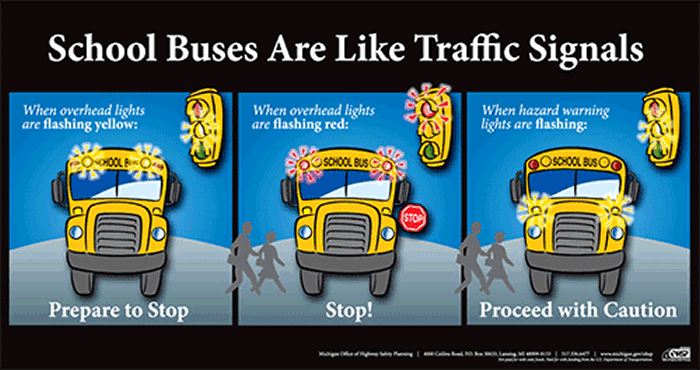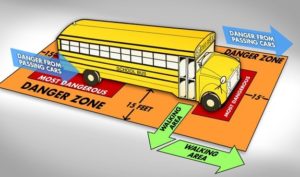BCS Transportation Department
Students must be at their designated stop at least 5 minutes before the scheduled time and visable to the driver. Be sure to allow enough time BEFORE AND AFTER the scheduled stop time until a routine is established. Buses cannot wait for late students. Stop times are approximate and may change without notice due to variables beyond our control.
If your student needs to ride to another location other then their assigned stop, you must call or send a note in with your student to their office to be issued a bus pass. The drivers will not accept notes, text messages or verbal requests from parents. BUS PASS must be issued from the attending school office.
Bus Safety Rules
At Bus Stops
- Be at the bus stop at least 5 minutes before scheduled bus stop time.
- Students must be waiting outside and visable to the bus driver. Not inside the house or in a vehicle. The bus will not wait or stop if your child is not outside waiting and visable.
- Be considerate of private property.
- Stay off the road while waiting for the bus.
- No ball playing or game playing is permitted at the bus stop.
- Wait until the bus comes to a complete stop before trying to get aboard. Do not crowd the entrance when getting on the bus.
- If you are late, please do not run after a moving bus.
- Parents are responsible for their children at bus stops till they load the bus.
- Put the cell phone away when boarding the bus. Attention needs to be on the driver and your surroundings.
On the Bus
- Keep your hands and head inside the bus at all times.
- Help keep the bus clean. Don’t throw trash on the floor or out the windows.
- Keep objects out of the aisle. Gym bags, instruments, or school projects must be held on your lap or under the seat in front of you, or they will not be allowed on the bus. All sports equipment must be in a contained bag.
- Find your assigned seat as soon as you board the bus. Do not leave your seat while the bus is moving.
- Absolute quiet is required when the bus approaches a railroad crossing.
- Always follow the directions of the bus driver.
- No smoking, lighted matches, or open flame is permitted in the bus.
- No eating or drinking is allowed on the bus.
Leaving the Bus
- Put the cell phone away while leaving the bus. Attention needs to be on the driver and your surroundings.
- Always cross the street in front of the bus where the driver can see you after being signaled to cross the street.
- Stay a safe distance away from the side of the bus.
- Parents are responsible for thier children at the bus stop once the bus unloads.
- Drivers are allowed to drop off passengers only at regular bus stops.
REMEMBER
Riding the bus is a privilege. These rules help ensure safe bus transportation for students and bus drivers. Students who violate these safety regulations may be excluded from riding the bus. Parents are responsible for transporting their child to and from school if the child has been excluded from bus transportation.
What to do when approaching a school bus with lights activated
MCL 257.682 MICHIGAN VEHICLE CODE (EXCERPT) Act 300 of 1949
- The school bus drivers use of yellow overhead flashing lights is indicating caution to drivers approaching the school bus, that the school bus is about to turn on the red flashing lights and come to a stop. When drivers see a school bus with the yellow overhead flashing lights activated they should begin slowing, look for children and be prepared to stop when the red flashing lights are activated. The operator of a vehicle overtaking or meeting a school bus that has stopped and is displaying 2 alternately flashing red lights located at the same level shall bring the vehicle to a full stop not less than 20 feet from the school bus and shall not proceed until the school bus resumes motion or the visual signals are no longer actuated. The operator of a vehicle who fails to stop for a school bus as required by this subsection, who passes a school bus in violation of this subsection, or who fails to stop for a school bus in violation of an ordinance that is substantially similar to this subsection, is responsible for a civil infraction.
- The operator of a vehicle on a highway that has been divided into 2 roadways by leaving an intervening space, or by a physical barrier, or clearly indicated dividing sections so constructed as to impede vehicular traffic, is not required to stop upon meeting a school bus that has stopped across the dividing space, barrier, or section.
- Public Act 187 of 1990 allows what is called a “hazard light stop” under limited circumstances. Motorists approaching a school bus that is utilizing this type of stop may pass the bus while it is picking up or discharging students. Motorists should always use care when doing so. In this type of stop, children are not allowed to cross the roadway but motorists should always be prepared for the unexpected and drive accordingly.
School Bus Danger Zones
There are blind spots where the bus driver can lose sight of a child:
- Front Danger Zone: It is never safe to walk close to the front of the bus. Children should walk ten giant steps ahead of the bus before crossing in front of it.
- Side Danger Zone: Children should always stay three giant steps away from the side of the bus.
- Rear Danger Zone: Never walk behind the school bus.
- Rear Danger Zone: Walk (don’t run) three giant steps away from the bus when exiting the bus. When the bus approaches, step back from the curb at least three giant steps.
Contact Information
Transportation Supervisor
Administrative Assistant
Please email any transportation issues here
More from BCS


Bucks Blast Newsletter

BUCKS in Action!

RFP – BHS Band Uniforms

Get Your BMS 23/24 Yearbook Now!




 Visit our School of Choice
Visit our School of Choice